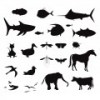
Image: Copyright BrotherSoft
Ever wonder how the patterns of stripes and spots develop in animals? Researchers Michael Cohen, Buzz Baum and Mark Miodownik were wondering the same thing and have published their findings in the Journal of the Royal Society Interface. They were able to construct a mathematical model to show how developing cells communicate with each other through actin-based filopodia, which are little projections from the cells. These filopodia communicate with other cells through chemical signals that can inhibit or stimulate to indicate which color each cell should be. As the cells develop and communicate with each other, complex patterns of stripes and spots (and stars?) that we see in animals begin to emerge. You can read the article here.

I just read an excellent discussion of this in a new book from the local library:
Endless Forms Most Beautiful-the new science of Evo Devo, by Sean B. Carroll. See ch.8: How the Butterfly got its spots. Highly recommended. Ch.9 is on melanism, gives a great explanation of stripes in the 3 zebra species (pg.241).